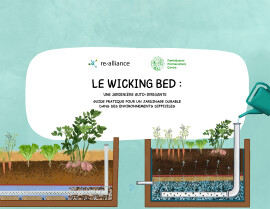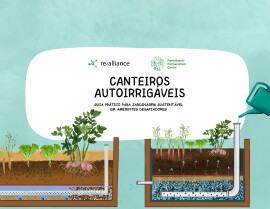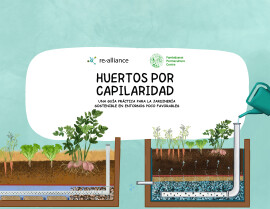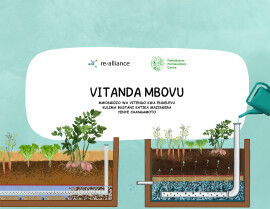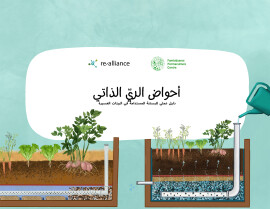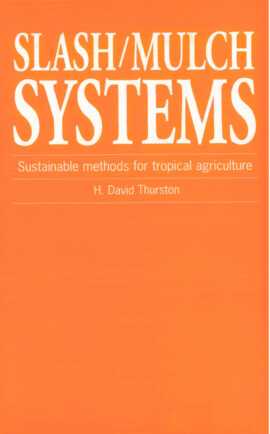
Slash/Mulch Systems
Sustainable methods for tropical agriculture
This informative overview and analysis of slash/mulch practices from around the world, particularly from the tropics, shows that they have generally shortened the necessary fallow periods and have restored degraded soils, thus increasing or stabilizing yields. These improvements, in turn, have allowed small-scale, resource-poor farmers to compete more effectively with larger commercial farmers and have enabled subsistence farmers to achieve food security.
Published: 1997
Pages: 216
Paperback: 9781853393402
| List of Tables and Figures | |||
|---|---|---|---|
| Preface | |||
| Acknowledgments | |||
| 1 Introduction | |||
| Traditional Farming Practices, 4 | |||
| Environmental Problems, 6 | |||
| Quality of Life in Developing Countries, 9 | |||
| Shifting Cultivation Systems, 10 | |||
| 2 Mulching | |||
| Terms Used Relative to Mulching, 19 | |||
| Materials Used as Mulches, 21 | |||
| Mulching Practices and Soil Erosion, 22 | |||
| Positive Effects of Mulches, 25 | |||
| Negative Effects of Mulches, 27 | |||
| Incorporation Versus Mulching, 28 | |||
| 3 SlashlMulch Systems in the Americas 31 | |||
| Slash/Mulch Systems Described by Spanish Chroniclers, 31 | |||
| Slash/Mulch Systems of the Pacific Coasts of South and | |||
| North America, 32 | |||
| Slash/Mulch Systems of the Amazon Basin, 39 | |||
| A Slash/Mulch System on Riverbanks in Belize, 43 | |||
| Frijol Tapado (Covered Beans) Systems, 44 | |||
| Maiz Tapado System in Costa Rica, 62 | |||
| Slash/Mulch Maize and Sorghum Systems in Honduras, 64 | |||
| Yucath Jack Bean and Other Mexican Slash/Mulch Systems, 67 | |||
| Slash/Mulch Systems Used to Establish Banana Plantations, 68 | |||
| Kudzu System in Peru, 70 | |||
| Hairy Vetch/Tomato System, 71 | |||
| 4 SlashIMulch Systems of Africa | |||
| Slash/Mulch Systems in Cameroon, 73 | |||
| Bahuku Slash/Mulch System in Zaire, 76 | |||
| Majangir Slash/Mulch System in Ethiopia, 76 | |||
| Tanzania Sunhemp System, 77 | |||
| Conclusions, 78 | |||
| 5 SlashIMulch Systems of Asia and the Pacific Islands | |||
| Slash/Mulch Systems on Mentawai, Indonesia, 79 | |||
| Swamp Rice System in West Kalirnantan, Indonesia, 81 | |||
| Indonesian Mulch-Rotation System, 82 | |||
| Slash/Mulch Systems of Papua New Guinea, 82 | |||
| Southwest Pacific Slash/Mulch Systems, 84 | |||
| Conclusions, 84 | |||
| 6 SlashIMulch Systems That Also Include Burning | |||
| Combined Slash/Mulch and Slash-and-Bum Practices | |||
| in Panama, 87 | |||
| Combined Slash/Mulch and Slash-and-Bum Practices | |||
| in the Amazon, 88 | |||
| "Bumt Earth in Sarawak, 89 | |||
| Eupatorium Inulifolium System in Sumatra, 90 | |||
| The Marcefio or Popal System in Mexico, 94 | |||
| Sierra Leone Coppicing System, 95 | |||
| Tembe-Thonga Slash/Mulch System in South Africa, 96 | |||
| The Kru Slash/Mulch System of West Africa, 97 | |||
| The Mountain Ok Taro System of Central New Guinea, 97 | |||
| Conclusions, 98 | |||
| 7 Breeding Crops for Traditional SlashIMulch Systems | |||
| 8 Cover Crops and Green Manure Crops | |||
| Cover Crops and Green Manures Used | |||
| in Developing Countries, 105 | |||
| Advantages/Disadvantages of Cover Crop/Green Manure | |||
| Systems, 107 | |||
| Velvetbean Slash/Mulch Systems, 110 | |||
| Lupine as a Slashed Green Manure in the High Andes, 125 | |||
| Conclusions, 126 | |||
| 9 Systems Using Slashed (Pollard, | |||
| Pruned, or Coppiced) Shrubs or Trees | |||
| Alley Cropping Systems, 128 | |||
| Costa Rican Erythrina/Coffee Systems, 142 | |||
| Other Uses of Eythrina in Agricultural Systems, 144 | |||
| Sudanese Acacia Coppicing System, 144 | |||
| Tanzanian "Fodder Tree" Coppicing System, 144 | |||
| Guatemalan Sauco Coppicing Systems, 145 | |||
| Conclusions, 145 | |||
| 10 Effects of Organic Mulches, Soil Amendments, and | |||
| Cover Crops on Soil-Borne Plant Pathogens and Their | |||
| Root Diseases, H. David Thurston and George Abawi 147 | |||
| Organic Matter and the Incidence and Severity of | |||
| Root Diseases, 149 | |||
| Mechanisms of Suppression of Soil-borne Pathogens | |||
| by Organic Matter, 152 | |||
| Germination/Lysis Phenomenon of Propagules of | |||
| Plant Pathogens, 153 | |||
| Competition for Nutrients, 154 | |||
| Production of Volatile and Non-Volatile Toxic Compounds, 154 | |||
| Modification of the Soil Environment, 155 | |||
| Interference with Inoculum Dissemination, 155 | |||
| Stimulation of Specific Antagonistic, Parasitic, or Predacious | |||
| Biological Control Agents, 155 | |||
| Conclusions and Future Research Needs, 156 | |||
| 11 Recommendations | |||
| Bibliography | |||
| General lndex | |||
| About the Book and Author |
H. David Thurston
H. David Thurston is professor of plant pathology at Cornell University

